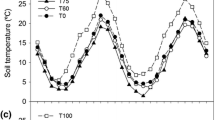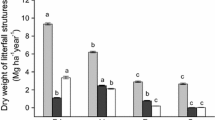Abstract
The management regime may have a significant impact on the productivity and dynamics of grasslands, but the causal relationships influencing grassland conservation value are still not completely understood. Changes of selected community characteristics, such as standing crop, proportion of forbs in the standing crop, litter amount, litter decomposition and seedling recruitment, were investigated in a 4 year manipulative experiment in a mountain grassland in Slovakia. The aim of the research was to compare changes in newly abandoned sites and sites where restoration measures were applied after 20 years of abandonment. The sites were located in areas containing two vegetation types of the Arrhenatherion alliance (wet Poo-Trisetetum and dry Anthoxantho–Agrostietum) with different moisture regimes. The expected increase of the standing crop after abandonment was rather slow, and more pronounced towards the end of the experiment, and in the wet meadow type (~30% increase). The restoration mowing promoted forb proportions in the biomass, but it did not decrease the standing biomass in the restored grasslands. Strong litter accumulation after abandonment was observed in subsequent years after abandonment, when the amount of litter increased about 100% in abandoned plots. Decrease in litter was also significant after the start of restoration mowing (a decrease from 258 to 159 g m−2 in wet type and from 287 to 147 g m−2 in dry type was noted). Accumulated litter was negatively correlated to seedling recruitment (r = −0.63 at the end of the experiment). The litterbag experiment showed that the wet type has a higher rate of decomposition, with 20% more biomass decomposed during the litter-bag experiment. The experiment confirmed a negative role of litter accumulation on seedling recruitment, with the number of seedlings per m2 decreasing from 413 to 321 individuals in the abandoned wet-type site. This may lead to a decrease in species richness. Mowing along with raking of mowed biomass may be a useful tool to restore degraded mountain grasslands and to remove accumulated litter from the stands.

Similar content being viewed by others
References
Bissels S, Donath TW, Holzel N, Otte A (2006) Effects of different mowing regimes on seedling recruitment in alluvial grasslands. Basic Appl Ecol 7:433–442
Bobbink R, Willems JH (1991) Impact of different cutting regimes on the performance of Brachypodium pinnatum in Dutch chalk grassland. Biol Conserv 56:1–21
Bobbink R, Willems JH (1993) Restoration management of abandoned chalk grassland in the Netherlands. Biodivers Conserv 2:616–626
Eler K, Vidrih M, Batič F (2005) Vegetation characteristics in relation to different management regimes of calcareous grassland: a functional analysis using plant traits. Phyton Ann Rei Bot 45:417–426
Foster BL, Gross KL (1998) Species richness in a successional grassland: effects of nitrogen enrichment and plant litter. Ecology 79:2593–2602
Galvánek D (2009) The species-rich grasslands of the Zázrivské lazy site in Slovakia. In: Veen P, Jefferson R, de Smidt J, van der Straaten J (eds) Grasslands in Europe of high nature value. KNNV Publishing, Kathrin Ohrmann, pp 196–201
Galvánek D, Lepš J (2008) Changes of species richness pattern in mountain grasslands: abandonment versus restoration. Biodivers Conserv 17:3241–3253
Galvánek D, Lepš J (2009) How do management and restoration needs of mountain grasslands depend on moisture regime? Experimental study from north-western Slovakia (Western Carpathians). Appl Veg Sci 12:273–282
Gross N, Bloor JMG, Louault F, Maire V, Soussana J (2009) Effects of land-use change on productivity depend on small-scale plant species diversity. Basic Appl Ecol 10:687–696
Hautier Y, Niklaus PA, Hector A (2009) Competition for light causes plant biodiversity loss after eutrophication. Science 324:636–638
Hector A, Beale AJ, Minns A, Otway SJ, Lawton JH (2000) Consequences of the reduction of plant diversity for litter decomposition: effects through litter quality and microenvironment. Oikos 90:357–371
Hellström K, Huhta AP, Rautio P, Tuomi J, Oksanen J, Kari L (2003) Use of sheep grazing in the restoration of semi-natural meadows in northern Finland. Appl Veg Sci 6:45–52
Herben T, Huber-Sannwald E (2001) Effect of management on species richness in grasslands: sward-scale processes lead to large-scale patterns. In: Multi-function grasslands. Proc. 19th general meeting of the European grassland federation, La Rochelle, pp 635–643
Herben T, Krahulec F, Hadincová V, Kovářová M (1993) Small-scale spatial dynamics of plant species in a grassland community over six years. J Veg Sci 4:171–178
Huber R (1994) Changes in plant species richness in a calcareous grassland following changes in environmental conditions. Folia Geobot Phytot 29:469–482
Huhta AP, Rautio P, Tuomi J, Laine K (2001) Restorative mowing on an abandoned semi-natural meadow: short-term and predicted long-term effects. J Veg Sci 12:677–686
Janeček Š, Lepš J (2005) Effect of litter, leaf cover and cover of basal internodes of the dominant species Molinia caerulea on seedling recruitment and established vegetation. Acta Oecol 28:141–147
Janišová M, Hájková P, Hegedüšová K, Hrivnák R, Kliment J, Michálková D, Ružičková H, Řezníčková M, Tichý L, Škodová I, Uhliarová E, Ujházy K, Zaliberová M (2007) Travinnobylinná vegetácia Slovenska—elektronický expertný systém na identifikáciu syntaxónov. Botanický ústav SAV, Bratislava
Klimeš L, Klimešová J (2002) The effects of mowing and fertilization on carbohydrate reserves and regrowth of grasses: do they promote plant coexistence in species-rich meadows? Evol Ecol 15:363–382
Křenová Z, Lepš J (1996) Regeneration of a Gentiana pneumonanthe population in an oligotrophic wet meadow. J Veg Sci 7:107–112
Kupferschmid AD, Stampfli A, Newbery DM (2000) Dispersal and microsite limitation in an abandoned calcareous grassland of the southern Prealps. Folia Geobot 35:125–141
Lanta V, Doležal J, Lantová P, Kelísek J, Mudrák O (2009) Effects of pasture management and fertilizer regimes on botanical changes in species-rich mountain calcareous grassland in Central Europe. Grass Forage Sci 64:443–453
Lepš J (1999) Nutrient status disturbance and competition: an experimental test of relationships in a wet meadow. J Veg Sci 10:219–230
Lepš J (2004) Variability in population and community biomass in a grassland community affected by environmental productivity and diversity. Oikos 107:64–71
Liu P, Huang J, Han X, Sun OJ, Zhou Z (2006) Differential responses of litter decomposition to increased soil nutrients and water between two contrasting grassland plant species of Inner Mongolia, China. Appl Soil Sci 34:266–275
Mašková Z, Doležal J, Květ J, Zemek F (2009) Long-term functioning of a species-rich mountain meadow under different management regimes. Agric Ecosyst Environ 132:192–202
Mayer R, Erschbamer B (2011) Seedling recruitment and seed-/microsite limitation in traditionally grazed plant communities of the alpine zone. Basic Appl Ecol 12:10–20
Pálková K, Lepš J (2008) Positive relationship between plant palatability and litter decomposition in meadow plants. Commun Ecol 9:17–27
Partzsch M, Bachmann U (2011) Is Campanula glomerata threatened by competition from expanding grasses? results from a 5-year pot-experiment. Plant Ecol 212:251–261
Perevolotsky A, Schwartz-Tzachor R, Yonathan R, Ne’eman G (2011) Geophytes–herbivore interactions: reproduction and population dynamics of Anemone coronaria L. Plant Ecol 212:563–571
Pokorny ML, Sheley RL, Svejcar TJ, Engel RE (2004) Plant species diversity in a grassland plant community: evidence for forbs as a critical management consideration. West North Am Nat 64:219–230
Quétier F, Thébault A, Lavorel S (2007) Plant traits in a state and transition framework as markers of ecosystem response to land-use change. Ecol Monogr 77:33–52
Rajaniemi TK (2002) Why does fertilization reduce plant species diversity? Testing three competition-based hypotheses. J Ecol 90:316–324
Rasran L, Vogt K, Jensen K (2007) Effects of litter removal and mowing on germination and establishment of two fen-grassland species along a productivity gradient. Folia Geobot 42:271–288
Rosenthal G (2006) Restoration of wet grasslands—effects of seed dispersal, persistence and abundance on plant species recruitment. Basic Appl Ecol 7:409–421
Ruprecht E, Enyedi MZ, Eckstein RL, Donath TW (2010) Restorative removal of plant litter and vegetation 40 years after abandonment enhances re-emergence of steppe grassland vegetation. Biol Conserv 143:449–456
Ryser P, Langenauer R, Gigon A (1995) Species richness and vegetation structure in a limestone grassland after 15 years management with 6 different biomass removal regimes. Folia Geobot Phytot 30:157–167
Schrautzer J, Jensen K (2006) Relationship between fight availability and species richness during fen grassland succession. Nord J Bot 24:341–353
Špačková I, Lepš J (2004) Variability of seedling recruitment under dominant, moss and litter removal over four years. Folia Geobot 29:41–55
Špačková I, Kotorová I, Lepš J (1998) Sensitivity of seedling recruitment to moss, litter and dominant removal in an oligotrophic wet meadow. Folia Geobot 33:17–30
Spiegelberger T, Matthies D, Müller-Scharer H, Schaffnerr U (2006) Scale-dependent effects of land use on plant species richness of mountain grassland in the European Alps. Ecography 29:541–548
Stampfli A (1995) Species composition and standing crop variation in an unfertilized meadow and its relationship to climatic variability during six years. Folia Geobot Phytot 30:117–130
Stampfli A, Zeiter M (1999) Plant species decline due to abandonment of meadows cannot easily be reversed by mowing. A case study from the Southern Alps. J Veg Sci 10:151–164
Stampfli A, Zeiter M (2008) Mechanisms of structural change derived from patterns of seedling emergence and mortality in a semi-natural meadow. J Veg Sci 19:563–574
van der Maarel E, Sykes MT (1993) Small-scale plant species turnover in a limestone grassland: the carousel model and some comments on the niche concept. J Veg Sci 4:179–188
Webster R, Holt S, Ch Avis (2001) The status of the Carpathians. WWF, Vienna
Willems JH, van Nieuwstadt MGL (1996) Long-term after effects of fertilization on above-ground phytomass and species diversity in calcareous grassland. J Veg Sci 7:177–184
Williams DW, Jackson LL, Smith DD (2007) Effects of frequent mowing on survival and persistence of forbs seeded into a species-poor grassland. Restor Ecol 15:24–33
Wilson JB, Watkins AJ (1994) Guilds and assembly rules in lawn communities. J Veg Sci 5:591–600
Xiong S, Nilsson C (1999) The effects of plant litter on vegetation: a meta-analysis. J Ecol 87:984–994
Xiong SJ, Johansson ME, Hughes FMR, Hayes A, Richards KS, Nilsson C (2003) Interactive effects of soil moisture, vegetation canopy, plant litter and seed addition on plant diversity in a wetland community. J Ecol 91:976–986
Acknowledgements
We would like to thank A. Dobošová, J. Galvánková, †V. Gavlas, S. Gavlasová, B. Immerová, Z. Imrichová, M. Kramárová, Ž. Šípková, A. Viceníková for the assistance with data sampling and biomass sorting and R. Lasák for help with mowing of the experimental plots and help with data storage and evaluation. We also appreciate the comments of Ján Šeffer and other colleagues on experimental design and data evaluation. Special thanks are to be given to local farmer Ján Matúš and his family for their kind hospitality during the field work and for providing the land for the experiments. The research was supported by the World Bank/Global Environmental Facility Project 'Central European Grasslands—Conservation and Sustainable Use'. The preparation of the article was supported by the grant SK0115 through the European Economic Area Financial Mechanism and the Norwegian Financial Mechanism. Funding was also received from the state budget of the Slovak Republic. Participation of JL was enabled by the grants MSMT 600-766-5801 and GAČR 206/09/1471.
Author information
Authors and Affiliations
Corresponding author
Electronic supplementary material
Below is the link to the electronic supplementary material.
Rights and permissions
About this article
Cite this article
Galvánek, D., Lepš, J. The effect of management on productivity, litter accumulation and seedling recruitment in a Carpathian mountain grassland. Plant Ecol 213, 523–533 (2012). https://doi.org/10.1007/s11258-011-9999-7
Received:
Accepted:
Published:
Issue Date:
DOI: https://doi.org/10.1007/s11258-011-9999-7




